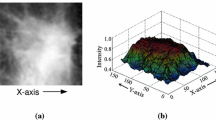Abstract
Several studies have showed that increased mammographic density is an important risk factor for breast cancer. Dense tissue often appears as textured regions in mammograms, so density and texture estimation are inextricably linked. It has been demonstrated that texture classes can be learned, and that subsequently textures can be classified using the joint distribution of intensity values over extremely compact neighbourhoods. Motivated by the success of texture classification, we propose an fully automated scheme for mammogram texture classification and segmentation. The classification method first has a training step to model the joint distribution for each breast density class. Subsequently, a statistical comparison is used to determine the class label for new images. Inspired by the classification, we combine the so-called image patch method with a HMRF(Hidden Markov Random Field) to achieve mammogram segmentation.
Preview
Unable to display preview. Download preview PDF.
Similar content being viewed by others
References
Varma, M.: Statistical Approaches to Texture Classification (2004)
Boyd, N.F., et al.: Quantitative classification of mammographic densities and breast cancer risk: results from the Canadian National Breast Screening Study. J. Natl. Cancer Inst. 87(9), 670–675 (1995)
Saftlas, A.F., Szklo, M.: Mammographic parenchymal patterns and breast cancer risk. Epidemiol Review 9, 146–174 (1987)
Oza, M., Boyd, N.F.: Mammographic parenchymal patterns: a marker of breast cancer risk. Epidemiol review 15, 196–208 (1993)
Wolfe, J.N.: Breast parenchymal patterns and their changes with age. Radiology 121, 545–552 (1976a)
Leung, T., Malik, J.: Representing and Recognizing the Visual Appearance of Materials using Three-dimensional Textons. International Journal of Computer Vision 43(1), 29–44 (2001)
Evertsz, C.J.G., et al.: Soft-copy reading environment for screening mammography - screen. In: Fifth International Workshop in Digital Mammogrphy, pp. 566–572 (2000)
Petroudi, S., Brady, M.: An automated algorithm for breast background segmentation. Medical Imaging Understanding and Analysis, 181–184 (2003a)
Duda, R.O., Hart, P.E.: Pattern Classificaton and Scene Analysis. Wiley, Chichester (1973)
Brault, P., Mohammad-Djafari, A.: Bayesian segmentation and motion estimation in video sequences using a markov-potts model. In: Proceedings of WSEAS Conference on Applied Mathematics 2004 (2004)
Evertsz, C.J.G., et al.: Highthroughput soft-copy reading system for digital mammography in nationwide european screening mammography programs: Requirements and first solutions. In: Proceedings of the Radiographic Society of North America (2000)
Petroudi, S., Brady, M.: Automatic nipple detection on mammograms. Medical Image Computing and Computer-Assisted Intervention, 971–972 (2003)
Marroquin, J.L., Santana, E.A., Botello, S.: Hidden Markov Measure Field Models for Image Segmentation. IEEE Pattern Analysis and Machine Intelligence 25(11), 1380–1387 (2003)
Author information
Authors and Affiliations
Editor information
Editors and Affiliations
Rights and permissions
Copyright information
© 2006 Springer-Verlag Berlin Heidelberg
About this paper
Cite this paper
Gong, Y.C., Brady, M., Petroudi, S. (2006). Texture Based Mammogram Classification and Segmentation. In: Astley, S.M., Brady, M., Rose, C., Zwiggelaar, R. (eds) Digital Mammography. IWDM 2006. Lecture Notes in Computer Science, vol 4046. Springer, Berlin, Heidelberg. https://doi.org/10.1007/11783237_83
Download citation
DOI: https://doi.org/10.1007/11783237_83
Publisher Name: Springer, Berlin, Heidelberg
Print ISBN: 978-3-540-35625-7
Online ISBN: 978-3-540-35627-1
eBook Packages: Computer ScienceComputer Science (R0)




